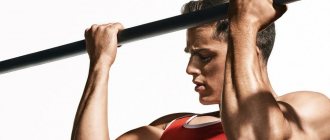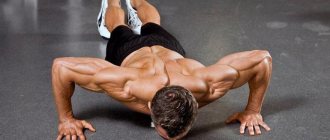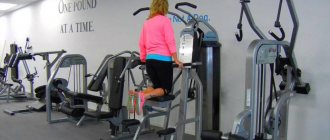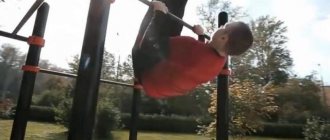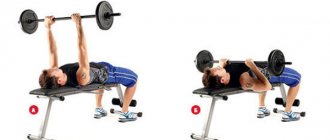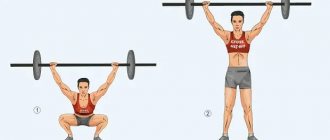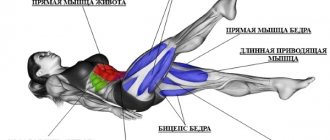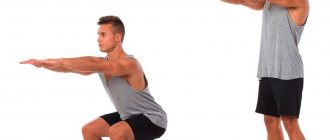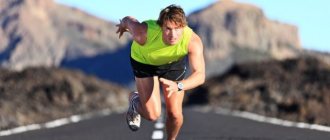Pull-ups are a basic and very effective exercise for developing back muscles. Despite the sparingness of the movement, which is essentially pulling the body by contracting the back muscles upward towards the bar, it is very difficult to perform. And all because initially the athlete lifts quite a lot of weight - his own. However, now you can resort to tricks in the form of elastic bands or a special exercise machine to be able to pull yourself up. This exercise cannot be neglected; it must be included in the training process of any athlete. Why? Let's figure it out now!
Benefits and disadvantages of wide grip pull-ups
- A highly effective exercise for training the back muscles.
- The muscles of the back and, to a lesser extent, the muscles of the arms are maximally involved.
- Strengthen and develop the muscle corset of the upper and middle spine.
- Develop muscle strength, volume and width of the back.
- They make a figure (torso) of the cherished triangular shape for men.
- Improves posture.
- A moderate tensile load is created on the thoracic spine and all the muscles of the core.
- The exercise is not just a posture corrector, but also helps correct diseases such as scoliosis, hyperlordosis, hyperkyphosis and ischemia of the intervertebral discs.
disadvantages . For example, any pull-ups are contraindicated for people with a herniated disc.
Tips and tricks
Experienced athletes recommend performing pull-ups with a parallel grip on a horizontal bar specifically designed for this purpose. Otherwise, the effectiveness of the exercise may decrease and the risk of injury may increase.
Also, during the upward movement, it is recommended to direct your arms so that at the top point your elbows are pressed as closely as possible to your body. And naturally, when performing an exercise, it is unacceptable to kick your legs and tremble your whole body in an attempt to gather yourself, hold on and do everything correctly - the body of the trainee must be in an ideal balance of composure and at the same time almost relaxed.
Finally, it is especially important to emphasize that when performing exercises, the trainee’s body should be kept as vertical as possible. If you want to add weight, it is recommended to add a little weight to special vests by hanging it on your belt.
What muscles work when doing pull-ups on the horizontal bar with a wide grip?
When performing wide-grip pull-ups, the rhomboid, latissimus, teres and trapezius muscles are the first to be loaded. Also involved in the work: the posterior bundles of deltoid muscles, biceps, forearms. When performing wide-grip pull-ups, the spinal extensors, serratus anterior muscles, and abdominal muscles act as stabilizer muscles
Muscles involved
Pull-ups on the horizontal bar in general are one of the most effective exercises for the back. A wide grip allows you to load the upper part of the latissimus muscle, which is largely responsible for the visually wide back.
So, what muscles work first:
- widest;
- diamond-shaped;
- big round.
Additional muscles (assistants) work:
- pectoralis major and minor;
- shoulder muscles;
- biceps.
Wide grip pull-up technique
- The starting position is hanging on the horizontal bar with your arms positioned at the optimal width, which is determined empirically, approximately one and a half shoulder widths.
- The arms in this position are fully straightened at the elbow joints. The lower back is relaxed.
- As you exhale, using the force of the target muscles, we pull the torso towards the bar. Try to touch the bar with your chin. The movement is performed smoothly, without jerking or other auxiliary movements.
- As you inhale, perform the reverse movement. This movement is also performed smoothly.
Classic version
Let's take a closer look at the implementation step by step. The execution rules are not complicated:
- Raise your hands, place them shoulder-width apart and grab the horizontal bar;
- If the bar is low, bend your legs so that your torso hangs in the air. It is advisable that the crossbar be located higher for comfortable performance of the exercise.
- Hang slightly under your own body weight. Then, with a smooth but energetic movement, begin to rise towards your chest so that your chin rises just above the bar. Don't make sudden movements!
- When you reach this position, without pausing, lower your body down.
- Keep all up and down movements under control. Stabilize your body by crossing your legs if you start to sway.
We return to the starting position without using sudden movements.
When performing the exercise, we direct the load on the following muscles:
- Latissimus;
- Diamond-shaped;
- The big round one.
We also use auxiliary muscles:
- Major and minor pectoralis;
- Biceps and triceps.
See also: Hyperextension at home - 5 varieties Exercise for the back with a roller from the Japanese scientist Fukutsuji
Common mistakes
A common mistake when performing wide-grip pull-ups is using a lot of weight (if performing the exercise with weights), or ignoring the auxiliary equipment discussed (elastic bands or graviton trainer). As a result, the athlete performs a small number of repetitions, and this is not the best way to develop the back. The back muscles love a high number of repetitions, especially if we are talking about pull-ups. Aim for a range of 10 to 15 reps.
General provisions
To understand the principles of the exercise, it is worth understanding each of its aspects:
- Who is it suitable for ? This type of pull-up is suitable for both beginners and professionals. Its advantage is that a large number of muscles are involved in the work (the exercise is considered basic).
- When to do it ? The best time to perform this is at the beginning of a workout aimed at working the back muscles. Once completed, move on to other exercises such as bent-over rows, front rows, T-bar rows, etc. In some cases, it is possible to perform pull-ups after deadlifts. The advantage of this alternation is the ability to stretch the spine.
- How much to do ? The total number of repetitions is 12-15 times, the number of approaches is 3-4.
- How to increase efficiency ? Over time, your own weight becomes small. In such a situation, add additional weight. The load is fixed on the belt. It is permissible to use wrist straps that securely secure the hands.
Implementation recommendations
- Pay attention to your grip width. The wider the grip, the less the arm muscles are used , and the range of movement is reduced.
- In order to reduce the load on the biceps or forearms, you can resort to using wrist straps or hooks.
- Wide-grip pull-ups should be the first exercise to develop your back muscles. The optimal execution scheme would be 3-4 sets of 10-15 repetitions.
- Is it possible to perform several variations of pull-ups at once? I guess, yes. For example, the first option is a wide grip behind the head, and the second is a reverse grip. In this type of training, the number of approaches should be reduced to 2-3.
Efficiency Tips
With the help of some technical nuances, you can significantly improve the impact of wide-grip pull-ups.
Two execution options are used - pulling up behind the head with a wide grip and pulling up to the chest.
There is still debate about which option is more effective. Well, bodybuilding “gurus” even talk about which specific muscle bundles are more activated in one form or another.
It’s even more strange to hear this about a basic exercise that loads almost the entire upper body.
Basic exercises are not intended for muscle detail. There are isolation movements for this.
As for both variations of pull-ups, they work the lats equally well and involve the same muscles.
It’s just that some feel the target muscles better when pulling up behind the head, while others feel the target muscles better when pulling up to the chest.
And this is the second secret of effective back pumping - the ability to “turn on” and feel the muscle group . A little knowledge of anatomy and studying the function of the lats will help you quickly master the ability to control the working muscles.
When doing pull-ups on the bar, their main task is to bring the shoulder blades together and bring the arm toward the body.
Once you learn to focus on this movement, your pull-ups will “go” through your lats.
This feeling is easier and faster to achieve when using a wide head grip. Maybe that’s why it’s widely believed that this option works these muscles better.
When pulling up to the chest, the lower back is bent and the chest is pushed forward. This starting position activates the lats in a static mode already at the start. Pulling up, the shoulder blades contract even more, forcing them to work to the maximum in dynamics.
Another subtlety - in the lower starting position you cannot straighten your arms at the elbow joints to the end. They remain slightly bent.
This position is beneficial for both the back and biceps. In addition, the muscles receive an additional stimulus for growth, being under constant tension throughout the entire exercise.
Professional bodybuilders go even further by holding for a second at the top of the movement. This technique is especially often used during relief work in order to improve the detail of the back muscles.
Increase the strength of your back muscles!
Pull-ups have no equal in effectiveness and versatility among other exercises for the back muscles.
Pull-ups pump up your back like no other exercise, but a few sets won't build up an impressive wing. Below you will find a truly effective workout plan for pumping up your back.
Raising your body from a hanging position sounds simple, but is not practical for most people. Many basic exercises, such as squats or various forms of push-ups, for example, are found quite often in everyday life, which cannot be said about pull-ups. Even the most pumped-up weightlifters would rather lie under the barbell than climb onto the horizontal bar, because the latter is incredibly difficult to do. Don't be scared right away if you don't succeed the first time. In any case, you have to start somewhere.
To pump up your back and avoid back problems, which are common lately, start doing pull-ups on the horizontal bar right now for preventive purposes and to strengthen your back. This exercise can easily be included in any training plan.
Hard grip[edit | edit code]
Another controversial issue in pull-ups is the grip. What is the best hand position on the bar - forward grip (fingers away from you), reverse grip (fingers towards you) or overhand (thumbs towards you)!
Let's first look at an important aspect of movement - pronation. This term is used by kinesiologists, and it means “rotation”, “turnover”. In the context of push-ups, he describes the phenomenon of turning your palms down as you bring them closer to your body.
The closer the palms are to the body, the more they rotate. This is a very small natural human movement. This may seem quite minor and usually does not interfere with standard pull-ups, but it becomes important as the exercises become more complex.
At first, perform pull-ups with a grip that is comfortable for you personally. But a direct grip (with your fingers facing away) is preferable for many, so all descriptions of the exercises are given taking into account a direct grip. A reverse grip is also acceptable. As you master the technique and progress through difficulty levels (especially full pull-ups), you will feel that the position of your hands will no longer be comfortable.
Experiment with different grips. As a general rule, if you have strong biceps, it will be easier to do pull-ups with a reverse grip. Choose the position that is comfortable for you.
The most advanced technique for performing this exercise is pull-ups on gymnastic rings. Gymnasts usually train on them. Rings are ideal for doing pull-ups because they allow the wrist to move naturally as you move.
